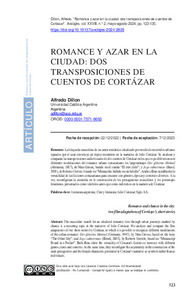Por favor, use este identificador para citar o enlazar este ítem:
https://repositorio.uca.edu.ar/handle/123456789/19048| Título: | Romance y azar en la ciudad: dos transposiciones de cuentos de Cortázar | Autor: | Dillon, Alfredo | Palabras clave: | LITERATURA ARGENTINA; CINE Y LITERATURA; Cortázar, Julio, 1914-1984 | Fecha de publicación: | 2024 | Editorial: | Universidad Nacional de La Pampa. Facultad de Ciencias Humanas. Instituto de Investigaciones Literarias y Discursivas. | Resumen: | La búsqueda masculina de un amor romántico idealizado por medio de recorridos urbanos signados por el azar constituye un tópico recurrente en la narrativa de Julio Cortázar. Se analizan y comparan las transposiciones audiovisuales de dos cuentos de Cortázar en los que es posible reconocer diferentes modulaciones del romance urbano cortazariano: los largometrajes Der gläserne Himmel (Alemania, 1987), de Nina Grosse, basado en el cuento “El otro cielo”; y Jogo subterraneo (Brasil, 2005), de Roberto Gervitz, basado en “Manuscrito hallado en un bolsillo”. Ambos films manifiestan la versatilidad de las ficciones cortazarianas para cruzarse con géneros, épocas y contextos diversos. A la vez, reconfiguran la asimetría en la construcción de los protagonistas masculinos y los personajes femeninos, presentados como símbolos antes que como individuos en la narrativa de Cortázar. The masculine search for an idealized romantic love through urban journeys marked by chance is a recurring topic in the narrative of Julio Cortázar. We analyze and compare the film adaptations of two short stories by Cortázar, in which it is possible to recognize different modulations of this urban romance: Der gläserne Himmel (Germany, 1987), by Nina Grosse, based on the story “The Other Sky”; and Jogo subterraneo (Brazil, 2005), by Roberto Gervitz, based on “Manuscript Found in a Pocket”. Both films show the versatility of Cortazar's fictions to intersect with different genres, times and contexts. At the same time, they reconfigure the asymmetry in the construction of the male protagonists and the female characters, presented in Cortázar's narrative as symbols rather than as individuals. |
Cobertura Temporal: | Siglo XX | URI: | https://repositorio.uca.edu.ar/handle/123456789/19048 | ISSN: | 1851-4669 (online) | Disciplina: | LITERATURA | DOI: | 10.19137/anclajes-2024-2829 | Derechos: | Atribución-NoComercial-CompartirIgual 4.0 Internacional | Fuente: | Anclajes. 2024, 28 (2) |
| Aparece en las colecciones: | Artículos |
Ficheros en este ítem:
| Fichero | Descripción | Tamaño | Formato | |
|---|---|---|---|---|
| romance-azar-ciudad.pdf | 361,77 kB | Adobe PDF |  Visualizar/Abrir |
Este ítem está sujeto a una Licencia Creative Commons

